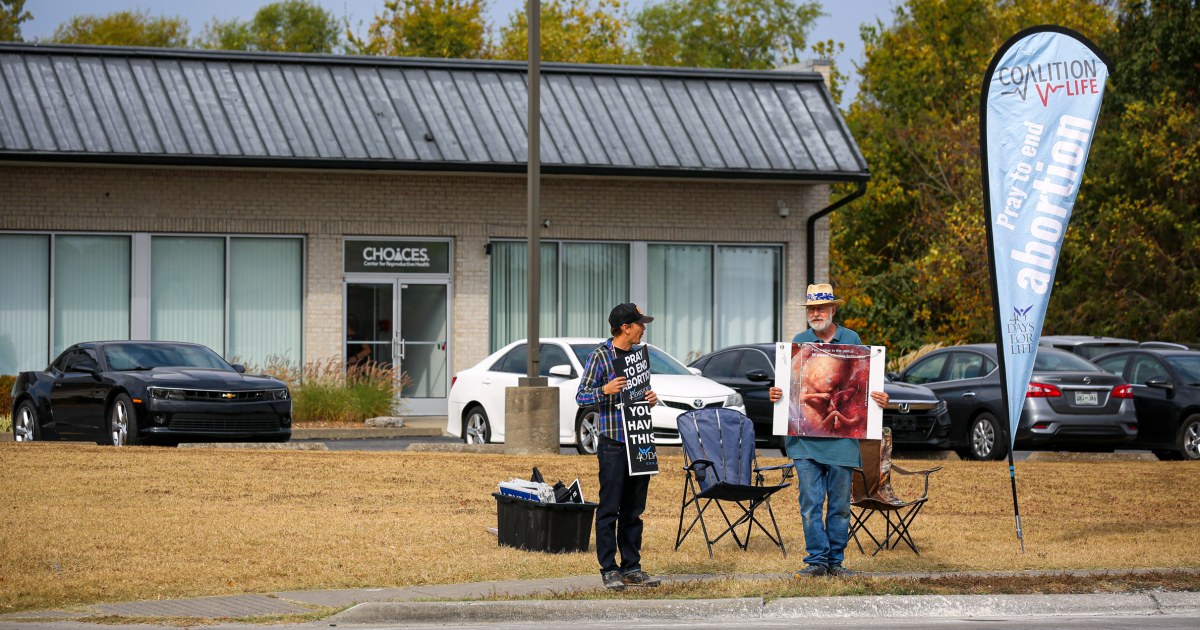The Supreme Court may soon consider two cases that could dismantle limits on how close protesters can be to people at abortion clinics and other health care facilities.
The cases argue that “buffer zones” around clinics and “bubble zones” around the people who visit them violate the First Amendment.
“Americans either have the right to speech or they don’t. We shouldn’t be practicing viewpoint discrimination,” said Kristan Hawkins, president of Students for Life of America, an anti-abortion group, which filed an amicus brief in one of the cases.
But supporters of the limits say they’re essential. Melissa Fowler, chief program officer for the National Abortion Federation, said that since Roe v. Wade was overturned, protesters have traveled from states where clinics have closed to states where they remain open.
Although there are some protections for clinics, including the federal Freedom of Access to Clinic Entrances or FACE Act that makes it a crime to block a facility’s entrance, patients and staff may still face intimidation.
Buffer zones where demonstrations are regulated, she said, allow “people to still have an area where they can protest, but it really protects people’s personal safety and autonomy.”
One of the cases the Supreme Court is being asked to consider originates out of Carbondale, a college town in southern Illinois that has become a critical access point for abortion care for residents in the South and the Midwest. At least a dozen states across those regions have greatly restricted or banned the procedure.
Since the Supreme Court overturned Roe v. Wade, three abortion clinics have opened in Carbondale.
Those arrivals also drew abortion opponents. Even if protesters aren’t aggressive, their presence can be stigmatizing or uncomfortable for patients, said Jennifer Pepper, president and CEO of Choices Center for Reproductive Health.

In the past, she said, some wore neon vests and displayed a “check-in” sign in an apparent effort to steer patients away.
“They just want to be left alone with their support to receive their health care,” she said of the patients. “They don’t want to be yelled at.”
In response to what it later described in court documents as a “marked increase” in intimidation, threats and interference from protesters, the city passed an ordinance in January 2023 that drew a 100-foot perimeter from the entrance of health care facilities, in which protesters were prevented from coming within 8 feet of a person without their permission.
Several other cities have sought similar ordinances; a new one was just passed by the Detroit City Council.
Almost immediately, Carbondale’s ordinance was challenged by Coalition Life, which filed suit in May 2023, calling the bubble zone unconstitutional.
“It had a very serious chilling effect, in regard to our team on the ground not knowing if they would cross a certain line or get arrested,” said Brian Westbrook, the group’s founder and executive director. “It definitely chilled our speech. It continues to chill our behavior there as well.”
Carbondale’s city council later repealed the ordinance in July 2024. In court documents, the city said that no one had been charged and existing laws offered sufficient protection.
But Coalition Life is pressing ahead with its lawsuit to prevent the bubble zone from returning, asking the Supreme Court to topple the precedent established in Hill v. Colorado.
In that 2000 decision, justices ruled that a Colorado law with similar guidelines to Carbondale’s was constitutional.
In response to questions, a spokesperson for the Thomas More Society, the conservative law firm representing Coalition Life, referred NBC News to the firm’s legal filings.

“The need to restore the First Amendment rights Hill eviscerated is all the more pressing after Dobbs,” the petition states, referring to Dobbs v. Jackson Women’s Health Organization, the 2022 Supreme Court decision that overturned Roe. It argues that bubble zones are more likely in places that support abortion rights, which is also where the activists have “the greatest potential for impact.”
In response, lawyers for Carbondale defended Hill’s precedent and said that the issue is moot since the ordinance was already repealed. An assistant city attorney declined to comment on the case, citing the ongoing litigation.
In New Jersey, a similar case has been brought by an anti-abortion activist who is challenging a buffer zone for health care facilities in Englewood, describing the restricted areas outside a local abortion clinic as an “obstacle course” that “plainly ‘abridges’ the right to free speech.” A spokesperson for the plaintiff’s law firm declined an interview request.
Englewood Mayor Michael Wildes, who supports the buffer zone, said, “It’s important for us to balance our personal politics with the privacy and dignity of families making choices.”
David Cohen, a law professor at Drexel University Kline School of Law, who has represented clinics in similar cases, said courts have allowed for certain restrictions on protests.
“You can’t have protests on the steps of the Supreme Court,” he said. “You can’t have pamphleteers right around a voting booth. You have to let people get in and out of the voting site unencumbered.”
He said justices may be reluctant to take up the Carbondale case, given that the ordinance is no longer in effect, and may be wary of abortion-related cases in general after hearing two in their most recent term. Last year, the justices declined to hear a case challenging a similar ordinance in Westchester, New York.
Neither petition has been scheduled to be discussed by the Supreme Court justices. Four justices will have to agree to hear the cases in order for the court to hear oral arguments and to issue a ruling.
The Supreme Court has yet to take on an abortion-related case this term. On Monday, it rejected an appeal from the Biden administration to hear a case about a policy meant to ensure patients in Texas could receive emergency abortion care. It also turned away a case involving Alabama’s Supreme Court ruling that threatened access to in vitro fertilization in the state.

Leave a Reply